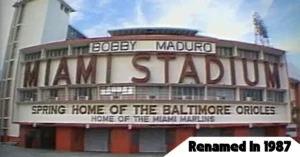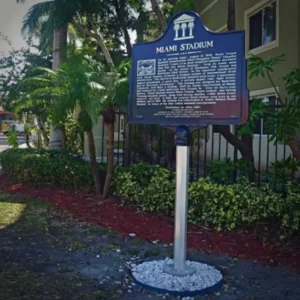The Bobby Maduro Miami Stadium formerly known as the Miami Stadium, served as a baseball stadium in the city of Miami, Florida. The Miami Marlins minor league baseball team used it as their home field as well as other minor league teams and thirteen thousand people were able to fit inside when it first opened in 1949.
An open area behind left field extended approximately a block north from Northwest 23rd Street, where first base was placed, to Northwestern 10th Avenue, where third base was located, and Northwestern 8th Avenue where right field was located.
With a high arched cantilever-type grandstand roof instead of the customary flat and slightly sloping or peaked roofs, the stadium was unique and the roof of the ballpark could be built without any posts obstructing the view of the fans below.
Who Played At The Bobby Maduro Miami Stadium
From 1950 to 1958, it served as the Dodgers’ spring training base of operations (for most of their “A” games). On March 8, 1958, the Dodgers played their inaugural spring training game as the Los Angeles Dodgers when they faced the Philadelphia Phillies in front of 5,966 people.
From 1959 to 1990, the Baltimore Orioles used it in the spring. Despite the fact that it would eventually be overtaken by more modern structures, Miami Stadium was impressively cutting-edge when it was built.
To prepare for the 1959 season, Orioles president James Keelty Jr. made a deal with Miami Marlins president George B. Storer on June 6, 1958 to move the Orioles’ spring training facility from Scottsdale, Arizona to Miami Stadium in Miami.
After announcing on May 25, 1990 that the Orioles will relocate their spring training home games from Miami Stadium to Bradenton and Sarasota in 1991, the team did so and to prepare for their spring games, the Orioles trained in Sarasota, Florida, at Twin Lakes Park.
The Renamed Bobby Maduro Miami Stadium
 Upon unanimous approval in February 1987, the Miami City Commission officially changed its name to the Bobby Maduro Miami Stadium in honour of the legendary Cuban baseball entrepreneur Bobby Maduro and the official ceremony was held in March 1987 where the name was installed above the iconic Miami Stadium sign.
Upon unanimous approval in February 1987, the Miami City Commission officially changed its name to the Bobby Maduro Miami Stadium in honour of the legendary Cuban baseball entrepreneur Bobby Maduro and the official ceremony was held in March 1987 where the name was installed above the iconic Miami Stadium sign.
The Bobby Maduro Miami Stadium Demolition And Documentary
The stadium had been targeted for demolition as part of the city’s plan to turn the land into warehouses but developers were put off by the sale price of $1.6 million and the demolition cost of $725,000 and as of 1998, the land had been listed for residential use.
However in 1999, St. Martin Affordable Housing Inc. paid $2.1 million to the City of Miami for the 12.6-acre (51,000-square-meter) site in order to demolish the stadium and build a housing development which now houses the Miami Stadium Apartments complex.
In 2007 an excellent PBS documentary White Elephant: What Is There To Save was made showing the history of the stadium and it’s ultimate demise.
 A GoFundMe page set up by Abel Sanchez in 2017 generated $2,500 for a historical marker at the location and the application was evaluated and approved by the Florida Department of State’s State Historical Marker Council.
A GoFundMe page set up by Abel Sanchez in 2017 generated $2,500 for a historical marker at the location and the application was evaluated and approved by the Florida Department of State’s State Historical Marker Council.
On December 16, 2017 at the site of Miami Stadium in Miami’s Allapattah neighbourhood, a historic marker marking the occasion was erected and this marker is still standing today as a symbol of one of Miami’s most famous and remembered sporting stadiums.

